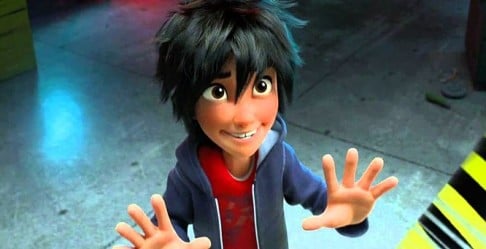
Why Disney's upcoming animated film may be one of the studio's most important
'Big Hero 6' is only the third movie in the Disney animated canon to star Asian protagonists

It will be the latest entry in Disney’s impressive cartoon canon, standing alongside animated heavyweights like Aladdin, The Lion King, and the studio’s recent hit, Frozen.
It will also be the first Disney animation to be adapted from a Marvel property, which in this case is a little-known comic book that first debuted in 1998. Considering that Disney has owned Marvel’s repertoire of characters since 2009 but been fairly slow at integrating them into animation, memorabilia and the theme park business, it’s about time.
But most important of all, Big Hero 6 will be one of the very few Disney animated features to star protagonists of colour.
In the original Marvel comics, Big Hero 6 refers to a team of superheroes that act as the protectors of Japan. In the upcoming film, which is due for a November release in the US, the team has been re-imagined in a more international setting that is still rooted in Asian imagery – “San Fransokyo”, a city designed to be a mishmash of San Francisco and Tokyo iconography.
At the centre of the film is Hiro Hamada, a teenage robotics expect who builds a friendly robot named Baymax and assembles a team of heroes to combat crime.
Watch: 'Big Hero 6' Trailer
While it might sound a bit cliché at first, the fact that a presumably Japanese-American protagonist is headlining this film is huge.
Despite Disney’s longstanding reputation with quality animation that has inspired children across the globe, calling the company “culturally progressive” would be generous at best.
In fact, in over fifty years of animation, the company has only produced a handful of features starring non-white main characters (animal protagonists like Bambi don’t count).
These include 1967’s The Jungle Book, 1992’s Aladdin,1995’s Pocahontas, 1998’s Mulan, 2000’s The Emperor’s New Groove, 2002’s Lilo & Stitch and 2009’s The Princess & the Frog.
Out of 53 animated movies, that’s only a stunning seven films. And of these films, only Mulan and Lilo & Stitch starred protagonists of East Asian or Pacific Islander descent – which means that Big Hero 6 is only the third Disney film to prominently feature Asians.

An early trailer for the movie looks promising. Hiro Hamada is shown placing robotic armour on his squishy companion Baymax, and the clip is filled with the fine animation and gags that have defined Disney for generations and will likely drive families in droves to see this new film.
With its Marvel connection, Big Hero 6 also stands poised to appeal to comic book buyers and supporters of the superhero genre – a dedicated, enthusiastic market that Disney probably should’ve dipped into sooner.
But more than anything else, Big Hero 6 has the potential to once again represent Asian faces in the world of animation. And the timing is good. While 1998’s Mulan may have delivered a tale based on the ancient Chinese legend of a girl who rides into battle to take the place of her ailing father, Big Hero 6 stands to capitalize on popular culture rather than history, riding the wave of “coolness” that Japanese manga and anime have delivered to the wide world.

The film’s setting and story also make sense from a business standpoint, since American movies featuring smatterings of the Orient tend to perform well internationally. (DreamWorks Animation’s 2008 hit Kung Fu Panda became the first animated film to earn more than 100 million yuan at the Chinese box office, and 2012’s Pacific Rim, a blockbuster inspired by Japanese creature features, recouped all of its costs thanks to impressive openings in China and Japan.)
Despite these positive prospects, naysayers could justifiably argue that Big Hero 6’s quasi-Japanese features may ultimately be nothing more than the animated equivalent of yellow face. The truth is, audiences can’t know for sure until they watch the film for themselves.
But in an age where white superheroes dominate the box office (Superman, Batman, Spider-Man, everyone in the Avengers…) and there have been 53 animated Disney films starring all manner of princesses, animals and anthropomorphic objects, I’d say that it's due time to see something that finally combines the genres together and throws a few coloured faces into the mix.
Because Asian Disney fans could use some big heroes too. And if we’re to get six of them with this movie, as the title implies – well, the more the merrier.

